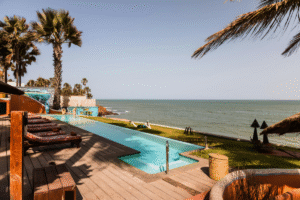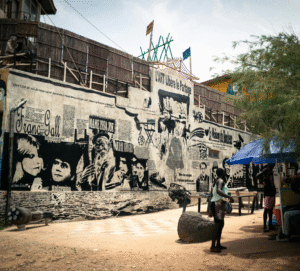Senegal: A Vibrant Nation of Culture History and Natural Beauty
Senegal, located on the west coast of Africa, is a nation known for its rich history, diverse cultures, vibrant music, and stunning landscapes. From the bustling capital of Dakar to the serene shores of the Casamance region, Senegal offers a unique blend of tradition and modernity. This comprehensive guide explores Senegal’s geography, history, culture, economy, tourism, and future potential, providing an insightful look into one of West Africa’s most dynamic countries.
Geography and Climate
Senegal is situated on the westernmost tip of the African continent, bordered by Mauritania to the north, Mali to the east, Guinea and Guinea-Bissau to the southeast, and the Atlantic Ocean to the west and southwest. The country also surrounds The Gambia, a narrow nation that extends inland along the Gambia River.
Covering approximately 196,712 square kilometers, Senegal’s terrain consists of plains, rolling hills, and some modest plateaus. The Senegal River forms much of the northern border, while the southern Casamance region is separated from the rest of the country by The Gambia.
Senegal has a tropical climate characterized by a wet season from June to October and a dry season dominated by the harmattan winds from November to May. Temperatures are generally warm year-round, making it an inviting destination for visitors.

Historical Background
Senegal’s history is rich and multifaceted, dating back thousands of years to ancient civilizations and trade networks.
The region was home to several powerful kingdoms, including the Jolof Empire and the Kingdom of Sine and Saloum, which thrived on trade, agriculture, and cultural exchange.
European contact began in the 15th century with Portuguese explorers, followed by French colonization in the 17th century. Senegal became a central hub in the transatlantic slave trade and later an important French colonial administrative center.
Senegal gained independence peacefully in 1960, with Léopold Sédar Senghor, a renowned poet and intellectual, becoming its first president. Senghor’s leadership helped shape Senegal’s identity as a democratic and culturally rich nation.
Senegal: A Vibrant Nation of Culture History and Natural Beauty
People and Culture
Senegal’s population exceeds 17 million, comprising various ethnic groups, the largest being the Wolof, followed by the Fula (Peul), Serer, and others.
Wolof is the most widely spoken language and serves as a lingua franca alongside French, the official language.
Senegal is renowned for its vibrant cultural heritage, especially its music and arts. Genres like mbalax, popularized by internationally acclaimed artist Youssou N’Dour, blend traditional rhythms with contemporary sounds.
Traditional wrestling, known locally as laamb, is a popular sport with deep cultural significance.
Senegalese cuisine features flavorful dishes such as thieboudienne (fish and rice), yassa (marinated chicken or fish), and maafe (peanut stew).
Religion is an important aspect of Senegalese life, with about 95% of the population practicing Islam, mostly of the Sufi tradition, fostering a culture of tolerance and spirituality.
Economy and Natural Resources
Senegal’s economy is diverse, with agriculture, mining, fishing, and services contributing to growth.
Agriculture employs a large part of the population, producing peanuts, millet, maize, sorghum, and cotton.
The country’s coastline supports a vibrant fishing industry, with fish being a major export.
Senegal is also rich in mineral resources, including phosphates, limestone, and gold, with ongoing efforts to develop mining operations.
In recent years, Senegal has attracted foreign investment in oil and gas exploration, signaling potential for future energy sector growth.
The services sector, especially tourism and telecommunications, plays a growing role in the economy.
Senegal’s political stability and economic reforms have made it a favored destination for business in West Africa.
Tourism and Attractions
Senegal offers diverse attractions for travelers seeking history, nature, and culture.
Dakar, the capital, is a lively city known for its markets, museums, music venues, and vibrant nightlife. The Île de Gorée, a UNESCO World Heritage site near Dakar, is a poignant reminder of the transatlantic slave trade.
The Pink Lake (Lac Rose), famous for its pink-hued waters caused by algae, is a popular tourist spot and salt harvesting site.
Senegal’s national parks and reserves, such as Niokolo-Koba National Park, protect a range of wildlife including lions, elephants, hippos, and various bird species.
The Casamance region, with its lush forests, rivers, and beaches, offers a tranquil escape and insight into the Jola culture.
Traditional festivals, like the Dakar Biennale and the Festival of the African Renaissance, celebrate the arts and heritage of Senegal.

Education and Healthcare
Senegal boasts a relatively developed education system compared to many other African nations.
Primary education is free and compulsory, with a growing number of secondary schools and universities, such as Cheikh Anta Diop University in Dakar, providing higher education.
The government and international partners have worked to improve literacy rates and educational access, especially for girls.
Healthcare services have improved over the years, with efforts to combat diseases such as malaria, HIV/AIDS, and tuberculosis.
Rural areas still face challenges in healthcare delivery, but ongoing investments aim to strengthen the system nationwide.
Senegal’s Role in Regional and International Affairs
Senegal is a respected member of regional organizations like the Economic Community of West African States (ECOWAS) and the African Union (AU).
It maintains strong diplomatic relations globally and participates actively in peacekeeping missions.
Senegal’s leadership in promoting democracy, human rights, and regional cooperation has earned it recognition as a stable and progressive nation in Africa.
Its strategic Atlantic coast location also makes it a vital player in maritime security and trade.
Challenges and Opportunities
Despite its progress, Senegal faces challenges such as:
- Poverty and unemployment, especially among youth
- Infrastructure needs including roads, energy, and water supply
- Climate change impacts, including droughts and coastal erosion
- Regional security threats
However, Senegal’s opportunities are promising:
- Expansion of renewable energy projects
- Growth in tourism and cultural industries
- Development of oil and gas sectors
- Increased investment in education and technology
Senegal’s continued political stability and commitment to reforms position it well for sustainable growth.
Conclusion
Senegal is a nation that beautifully balances tradition and modernity, offering a rich cultural tapestry and a promising future.
Its history of resilience, artistic excellence, and economic potential make it a standout country in West Africa.
For travelers, investors, and scholars, Senegal represents a land of discovery, innovation, and vibrant life.
Exploring Senegal means engaging with warm people, fascinating history, and breathtaking landscapes.
Botswana: The Heart of Southern Africa



